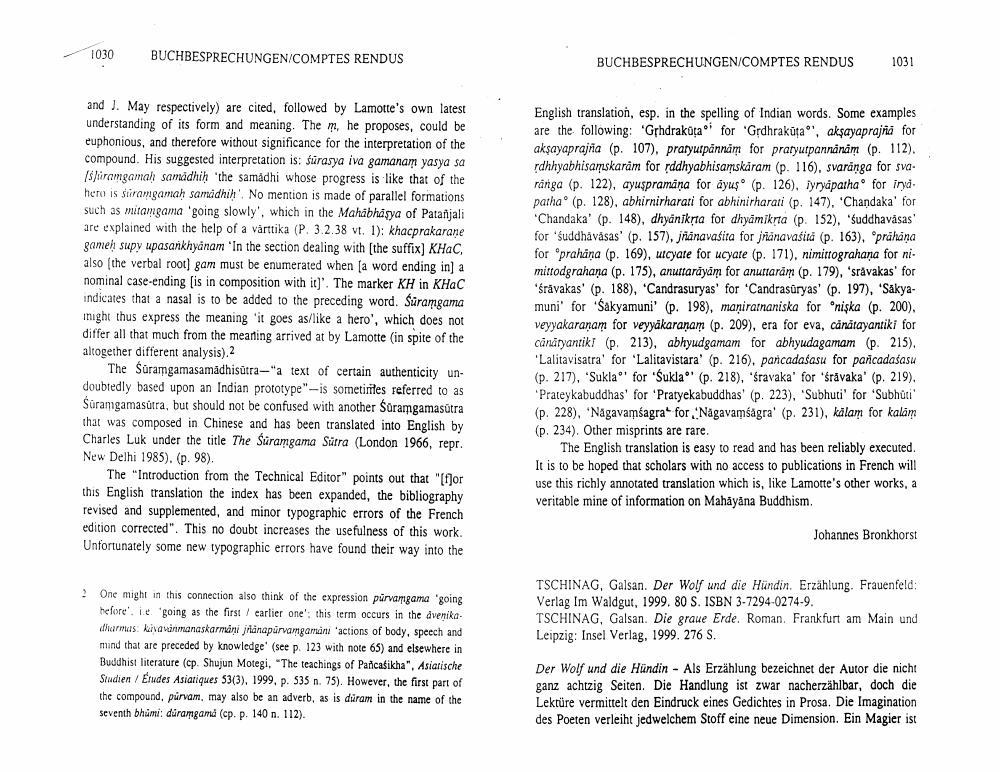Book Title: Buchbesprechungen Comptes Rendues Author(s): Johannes Bronkhorst Publisher: Johannes Bronkhorst View full book textPage 5
________________ 1030 BUCHBESPRECHUNGEN/COMPTES RENDUS BUCHBESPRECHUNGEN/COMPTES RENDUS 1031 and ). May respectively) are cited, followed by Lamotte's own latest understanding of its form and meaning. The m, he proposes, could be euphonious, and therefore without significance for the interpretation of the compound. His suggested interpretation is: šūrasya iva gamanam yasya sa Ispiramgamah samadhih 'the samadhi whose progress is like that of the here is stiramgamah samadhih. No mention is made of parallel formations such as mitamgama 'going slowly', which in the Mahabhasya of Patanjali are explained with the help of a vårttika (P. 3.2.38 vt. 1): khacprakarane gameh supy upasankhyanam 'In the section dealing with the suffix] KHAC, also the verbal root) gam must be enumerated when [a word ending in a nominal case-ending (is in composition with it). The marker KH in KHAC indicates that a nasal is to be added to the preceding word. Süramgama might thus express the meaning it goes as/like a hero', which does not differ all that much from the meaning arrived at by Lamotte (in spite of the altogether different analysis).2 The Suramgamasamadhisūtra-"a text of certain authenticity un doubtedly based upon an Indian prototype"-is sometiriles referred to as Süramgamasutra, but should not be confused with another Süramgamasutra that was composed in Chinese and has been translated into English by Charles Luk under the title The Süramgama Sutra (London 1966, repr. New Delhi 1985). (p. 98). The "Introduction from the Technical Editor" points out that "Ifjor this English translation the index has been expanded, the bibliography revised and supplemented, and minor typographic errors of the French edition corrected". This no doubt increases the usefulness of this work. Unfortunately some new typographic errors have found their way into the English translation, esp. in the spelling of Indian words. Some examples are the following: 'Grhdrakuța for 'Grdhrakura", aksayaprajna for aksayaprajna (p. 107). pratyurpannām for praryutpannanam (p. 112). rdhhyabhisarskardm for rddhyabhisaskaram (p. 116), svaranga for sva rånga (p. 122), ayuspramana for ayus (p. 126). Iyyapatha for ind pathao (p. 128), abhirnirharari for abhinirharari (p. 147). "Chandaka' for "Chandaka' (p. 148), dhyanikta for dhyamikrta (p. 152). Suddhavasas' for 'Suddhavasas' (p. 157).jranavasita for jhanavasita (p. 163), prahana for "prahana (p. 169), utcyate for ucyate (p. 171), nimittograhana for ni. mitrodgrahana (p. 175), anuttarayam for anuttaram (p. 179). 'sråvakas' for Sravakas' (p. 188), 'Candrasuryas' for 'Candrasuryas' (p. 197). 'Sakyamuni' for 'Sakyamuni' (p. 198), maniratnaniska for oniska (p. 200), veyyakaranam for veyyakaranam (p. 209), era for eva, canatayantiki for cānāryantik! (p. 213), abhyudgamam for abhyudagamam (p. 215). 'Lalitavisatra' for 'Lalitavistara' (p. 216). pancadasasu for parcadašasu (p. 217), 'Sukla' for 'Sukla' (p. 218), 'Sravaka' for 'śrävaka' (p. 219). "Prateykabuddhas' for 'Pratyekabuddhas' (p. 223). 'Subhuti' for 'Subhuti (p. 228). 'Nagavamsagra for Nagavamsagra' (p. 231), kalam for kalam (p. 234). Other misprints are rare. The English translation is easy to read and has been reliably executed. It is to be hoped that scholars with no access to publications in French will use this richly annotated translation which is, like Lamotte's other works, a veritable mine of information on Mahāyāna Buddhism. Johannes Bronkhorst ? TSCHINAG, Galsan. Der Wolf und die Hündin. Erzählung. Frauenfeld: Verlag Im Waldgut, 1999. 80 S. ISBN 3-7294-0274-9. TSCHINAG, Galsan. Die graue Erde. Roman. Frankfurt am Main und Leipzig: Insel Verlag, 1999. 276 S. One might in this connection also think of the expression purvarigama 'going before it going as the first / earlier one's this term occurs in the avenika dharmas kuivavarmanaskarmáni franapúrvamgaman 'actions of body, speech and mind that are preceded by knowledge' (see p. 123 with note 65) and elsewhere in Buddhist literature (cp. Shujun Motegi. "The teachings of Pancasikha". Asiatische Studien / Erudes Asiatiques 53(3). 1999, p. 535 n. 75). However, the first part of the compound, purvam, may also be an adverb, as is důram in the name of the seventh bhumi: duramgama (cp. p. 140 n. 112). Der Wolf und die Hündin - Als Erzählung bezeichnet der Autor die nicht ganz achtzig Seiten. Die Handlung ist zwar nacherzählbar, doch die Lektüre vermittelt den Eindruck eines Gedichtes in Prosa. Die Imagination des Poeten verleiht jedwelchem Stoff eine neue Dimension. Ein Magier istPage Navigation
1 ... 3 4 5 6
